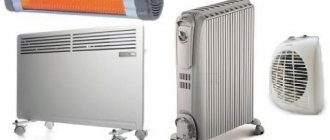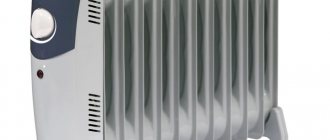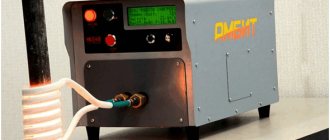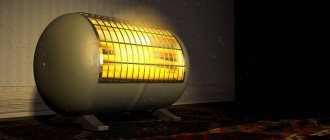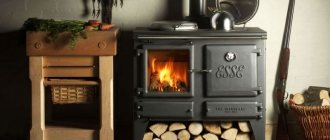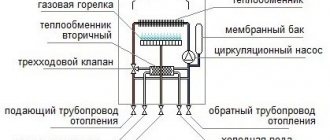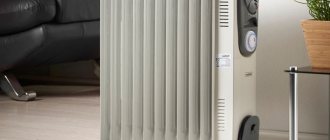Oil radiators are an excellent option for economical heating of a room. They are actively used in apartments, private homes, offices and warehouses all over the world. A good heater can provide up to 99 percent energy efficiency because almost all the electricity consumed is converted into heat, and this is one of its main advantages.
Today there is a wide range of heating equipment, in the labyrinths of which it is not difficult for an inexperienced buyer to get lost, so today we have presented the most complete answer to the question: how to choose an oil heater for the home. We'll also talk about what you need to know before you buy and see what the experts have to say. So, let's go!
Oil heating devices
This type of equipment is familiar to many and has been successfully used for heating residential premises for a long time. As the name suggests, such devices resemble a central heating radiator in appearance: a ribbed body consisting of several sections.
Temperature and heating intensity controls are located on the external panel; there is often a small fan that provides air convection. More modern models have an LCD display with a control panel.
A heating element is installed inside the housing, which heats the oil circulating in the tanks to a predetermined temperature. The coolant circulates, first warming up the radiator body and then the air in the room. It should be noted that oil radiators are available only in a floor-standing version.
Considering that such devices pose a certain fire hazard, there is always a sensor inside that automatically turns off the power supply if the heater accidentally falls on its side.
Which heater is better for constant use: oil or convector
We have outlined all the comparative characteristics of both types of heating equipment. Let’s summarize by indicating which one is ideal for regular use. In houses with many rooms, you will in any case have to acquire several devices, but electric convectors show greater productivity. These devices begin heating the room instantly, and it will be comfortable to be in the room immediately from the moment the device is turned on.
According to users, an oil cooler is slow when it comes to heating, and it is not suitable when you need to get the heat up quickly. Our editors have determined that an electric convector is best suited for continuous use during the winter season.
Equipment categories
- Kitchen appliances
- Electronics
- Smartphones
- BY
- Appliances
- TVs
- Reviews
- Ratings
DESIGN AND CHARACTERISTICS
The power of household devices on the market is usually 0.5–3 kW. The standard power step is 0.5 kW, although other options are possible.
There are several principles for selecting an oil heater for a specific room, however, if you do not want to carry out calculations and look for a suitable model, you can settle on the standard and most common power of devices - 2 kW.
The design of radiators of this type is standard, and manufacturers do not make significant changes to it.
Among the minor design features of different heater models are:
- the presence of handles for carrying;
- wheels or slides for moving on the floor;
- heat-insulating casing.
Handles are not a mandatory element, but are provided in almost all modern devices; All radiators have wheels or skids, depending on the model.
If possible, you should purchase devices equipped with protective covers: this will avoid serious burns that occur when coming into contact with the surface of the device. A high-quality casing is especially important when installing the device in a children's room. The only disadvantage of such insulation is the difficulty in cleaning the radiator grilles.
It is necessary to pay attention to the number and size of sections of the apparatus. Narrow sections (ribs) heat up faster themselves, but due to the small heat exchange surface they slowly warm up the environment; after switching off, appliances with narrow fins take longer to cool down, continuing to heat the room. Wide sections, although they heat up more slowly, transfer heat to the outside environment much better, and the room warms up faster
At the end of the heater operation, such sections cool down faster than narrow ones. In addition, devices with narrow fins consume less electricity, which allows us to talk about them as more energy efficient devices.
Wide sections, although they heat up more slowly, transfer heat to the external environment much better, and the room warms up faster. At the end of the heater operation, such sections cool down faster than narrow ones. In addition, devices with narrow fins consume less electricity, which allows us to talk about them as more energy efficient devices.
Additional functions vary for each commercially available model; each residential owner can choose the ideal combination of heater options for himself.
Modern devices may have the following elements in their design.
Heating mode switch
or temperature controller, giving users the opportunity to choose the operating power of the device, and therefore the room temperature.
Timer
on/off, with which you can heat the room in advance, before people arrive, or leave the device in working condition, without fear of excessive energy consumption.
Humidifier
, relieving the occupants of the room from the main disadvantage of oil radiators - dry air. It is a container with water that evaporates during the operation of the heater.
Fan heater
, activating heat exchange in the room due to mechanical distillation of air masses.
Fireplace effect
— thermal slots that accelerate heat transfer from the surface of the device to the air by almost half.
overheat protection
— the most important option that increases the fire safety of the device. It turns on when the permissible temperature value on the heating elements is exceeded.
Dryer
, which makes it possible to use the thermal energy released by the device into the air to dry wet things without the risk of fire. It should be remembered that drying any products directly on the radiator body is strictly prohibited.
Main characteristics of modern oil radiators
Experts highlight the following technical characteristics that distinguish modern oil radiators from other types of heating devices.
Safety shutdown
When choosing a portable oil heater, make sure it has safety shut-off features to minimize the risk of fire. Options should include overheat protection and rollover protection. Some models also offer freeze protection to ensure the oil doesn't freeze if it gets too cold when stored in freezing temperatures for long periods of time.
Manufacturer's warranty
Be sure to look for an oil heater that is backed by a solid warranty from a reputable company. There are many heater manufacturers and sellers out there, and not all heaters are designed to be super reliable and long lasting. You don't want to invest in a new heater only to have it break shortly after purchase and find that you have no way to replace it.
Incremental thermostat
While all oil heaters come with adjustable thermostats, those with gradual changes are the most customizable, allowing you to increase or decrease the heater's temperature by one degree. Some oil heaters offer very limited temperature settings, making it difficult to achieve the desired level of heat in a room.
Multiple heat settings
A good oil heater will allow you to customize the amount of heat produced depending on your needs or comfort level. Look for a heater that offers at least two or three heat settings ranging from low to high.
Other Considerations
Heat capacity
Consider the size of the space in which you will be using the oil heater. Large rooms require 900 to 1,500 watts of heating power, while small offices, bathrooms and bedrooms can be adequately heated with a 300 to 500 watt heater. If you are going to heat a small room, then a larger and more expensive heater is not necessary.
Mobility
If you plan to use your oil heater in different areas of your home or office, ease of portability is key. Some oil heaters are bulky and much heavier than other models. Does the device have wheels for easy transportation?
Types of oil heaters
When choosing a heater, you also need to pay attention to the design profile. It can be ribbed or flat
Ribbed
Ribbed oil heaters are shaped like the usual cast iron radiators, as they are also made of many sections. Sections of the electrical device are made by welding and further pressing. Most often, the thickness of steel can vary from 0.8 to 1 mm. Tightness is achieved thanks to laser cutting, which very accurately and evenly makes the required dimensions. High temperature also does not deform the body or joints.
Finned Oil Heater
After the body is made, holes are cut into it, passing through each individual section. This is done for their communication with each other. Once the device is technically ready, it is painted with powder paint and then placed in an oven to polymerize the coating.
This type of housing makes the device durable and efficient, since it has more area for heat transfer. True, in this case the oil heater will have considerable weight and a fairly large structure.
Flat
Flat heaters are two plates welded together, which have recesses on the body for heating elements and oil. This device is less efficient, but it also consumes less electricity. In addition, a flat heater does not have as much weight as a ribbed one and therefore can be mounted on a wall.
A flat oil heater can be made of steel, aluminum or an alloy of these metals. Steel appliances tend to be heavier and can cause damage if dropped. Aluminum is lighter, but less powerful.
Flat heater can be wall mounted
The most expensive devices are those made of aluminum and steel.
Important! Bimetallic devices may make a cracking sound when heated or cooled. This is due to the difference in thermal expansion between steel and aluminum.
How does an oil heater work?
The pros and cons of oil heaters have been discussed many times. The undoubted conclusion is that it is the best choice for small privateers. An oil heater is called an oil heater because it contains oil inside the tank, a working medium that simultaneously satisfies a number of criteria:
- Oil has a low coefficient of thermal expansion. For example, for water heaters this is a difficulty. When a fence is made from the riser, a cycle of temperature rise begins, the liquid expands at different speeds. Water's thermal expansion coefficient is many times higher than that of steel. The surface of the tank is often covered with enamel, which has temperature characteristics similar to metal. This makes the device durable, otherwise, if the paint layer becomes cracked, corrosion will begin and the tank will leak. To avoid such difficulties, water is not poured into the oil heater. When boiling, steam would form and rupture the tank.
- The entire world of heating technology is concerned about electrochemical corrosion, when two metals are placed in water (with salt solutions), as a result, current begins to flow between the electrodes. The first piece is restored, the second is destroyed. For obvious reasons, copper rivets are prohibited in aviation. Otherwise, the wing planes and the fuselage surface will begin to collapse. Aluminum is considered a donor; if the heating element is made of copper, the steel accordion body will feel the damage. As a result, the oil will leak onto the floor the next time you turn it on. If a liquid was poured inside, allowing a current of charge carriers to pass through, electrochemical corrosion would become the scourge of heaters. This doesn't happen.
- Security is closely related to the previous property. The heating element represents a tube into which the powder is pressed. There is a spiral in the heart that allows current to pass through and gives heat. If the tube is pierced, the powder gets wet and crumbles, resulting in potential on the body. A short circuit depends on the nature of the damage and does not always occur. Therefore, in an aquatic environment there would be a possibility of electric shock if the device is not properly grounded. In the case of an oil heater, the chance is less. However, the grounding terminal should not be left hanging in the air; place the eyelet on the neutral wire of the phase. Then, when potential appears on the housing, a short circuit will occur. As a result, the heating element or the fuse on the electrical panel will burn out.
- Oil boils at a higher temperature (olive oil - 150 degrees Celsius) than water. Therefore, the radiator is heated above 100 ºС, performance will not be lost. The upper limit of operation is determined by a thermal fuse mounted on the inside of the housing in the area of the heating element. An element is needed in case the device's thermostat fails. Unlike water heaters, in this case the sensor is not installed on the surface of the heating element. A bimetallic plate is located in the electronic unit and controls the air temperature. If it jams, the settings will be lost, the thermal fuse will save the situation. Thus, the operating principle of an oil heater is fundamentally different from a water heater. Remember if you need to replace the heating element.
Inside the tank, in addition to oil, one-eighth of the container contains atmospheric air.
It's a matter of oxidation. The oil will start to burn if you turn the oil heater upside down and turn it on, the heating element will be in an aggressive oxygen environment. First, carbon deposits will appear, then the heating element will begin to fail. The operating temperature will increase, later the process will increase, and the oil will begin to burn out. For this reason, some devices are equipped with fall sensors. A fire is impossible, the temperature of the oil heater is not so high, a thermal fuse will protect against overheating. The latter stands on the body near the heating element to protect the device if the oil leaks out or the radiator falls and the heater tube ends up in the air.
How does an oil heater work? The heating element consists of two spirals that work separately or together. The exit to emergency mode is controlled by a thermal fuse. The thermostat is built on the basis of a bimetallic plate, like in a household iron. Turning the knob changes the tension, hence the response temperature is different. The bimetallic plate does not touch the body, this is different from the iron. Usually located on the electronics casing, mounted on the side of the radiator. Air passes through the slots from the floor to the ceiling of the compartment, bypassing the sensor. It triggers at the right moment. We believe that the casing heats up due to conduction, but the temperature is lower than the oil. You can easily verify this with your own hand by touch when the device is turned on.
Features of oil heaters - the mode does not directly depend on the temperature of the coil. We see the difference from the iron, where the bimetallic plate is attached to the soleplate next to the thermal fuse. Sensors cannot be replaced directly. So:
- The device turns on.
- Goes into mode.
- It is switched off at the right time by a bimetallic strip.
- It's cooling down.
- Turns on again.
Therefore, the sensor is not attached to the body. The accordion changes temperature too quickly (despite its impressive volume). As a result, the relay will operate more often, and the operating life in hours would decrease. There would be no way to control the air temperature. In order for the radiator to deliver power, it must have a fixed temperature difference between the room atmosphere and the surface. We think that the control method chosen by the manufacturers looks more effective, and in addition, it is convenient to display the adjustments on the front panel.
As a result, the operating principle of an oil heater comes down to the natural circulation of oil inside the radiator.
Installation Rules
- The optimal distance from the radiator to the outlet is no more than 30 cm.
- The socket should be located on the side or below the device body and in no case higher.
- There should be no obstacles or furnishings closer than 30 cm on all sides of the radiator.
- The panel should be 3-5 cm away from the wall in accordance with the manufacturer’s requirements, which must be specified in the instructions.
- Do not use an oil radiator to dry clothes or any objects. It must not be covered with a cloth or interfere with heat transfer in any way.
- It is better to supply power for a stationary heater to a separate circuit breaker in the distribution panel or to a group of fuses when using several heaters throughout the house.
It is best to install the radiator in the place of the greatest heat loss, under the window opening. Naturally, with the condition that the radiator will not be covered with heavy tulle or curtains. Otherwise, it is better to place the heater on a wall bordering the street so that nothing interferes with heat exchange.
Oil cooler operation
An oil heater for home does not require any special care or maintenance during use. If the device has not been used for a long time, then before turning it on, it is necessary to wipe the device with a damp cloth, and also check the structure for integrity and the presence of oil leaks. In case of oil leakage, you must contact the manufacturer's specialized service center. It is not recommended to open it yourself or add oil yourself.
If the heater is turned on for the first time, it is best if it is in a well-ventilated room.
Catania ROR-C7-1500M. Weight – 7.87 kg. Dimensions – 350x125x640mm.
It is not recommended to hang wet clothes directly on the body of the device to dry, this can lead to fire after drying, especially for synthetic materials. It is recommended to dry clothes at some distance from the operating heater, or on a special towel rail, which is often supplied.
Oil radiators should not be used in rooms with high humidity (bathrooms, showers, dressing rooms, etc.), because Moisture getting into the control panel may cause the device to fail. However, this does not apply to devices that are recommended by the manufacturer for use in such premises.
Oil-filled radiator H-HO-7-05-UI891. Power – 1000 W, number of sections – 5, number of modes – 3.
If an oil heater has not yet been purchased, then first you need to decide on the area that the device will heat. On average, you should proceed from the calculation of 1 kW per 10 m². Secondly, you need to pay attention to the functionality of the device, on which its price largely depends.
Oil heater operating life
The advantages of oil heaters are fault tolerance. The simplest design is reminiscent of irons that work for years. Lack of electronics that are afraid of power surges. Oil heaters are not afraid of falling; a number of models have protection against this.
Home heater
Which one will work longer, big or small? For the first, the heating element works more often; for the second, the wear will fall on the bimetallic relay. To check the uptime, we will find facts or ask the manufacturer for information about the time between failures of the first and second parts. Let's calculate the cost of repairs. Single copies stand out from the line, but the statistics, on average, are known.
There is less chance of accordion breakdown on a large radiator. Its inertial properties are great, so the modes are smoother. Consequently, temperature deformations do not have a noticeable force. There are more sections, therefore, the probability of failure increases proportionally. You see, from a longevity perspective, it's hard to settle on a fixed size.
Operating principle and design of an oil heater
An oil heater is nothing more than a metal structure in the form of a housing, inside of which there is a container with special mineral oil and a heating device. Outwardly, they resemble ordinary batteries, due to the presence of many divisions. The operating principle of devices of this kind is as follows:
- when the heater is turned on, the heating element starts to work, heating the oil;
- boiling oil gradually gives off its heat to the metal body, which in turn promotes the convection processes of warm air.
The time it takes to completely warm up the room directly depends on the configuration of the radiator, the main models of which will be discussed a little later.
Oil heaters are usually used to warm up one room, but due to the ease of their movement, one powerful radiator can easily maintain an acceptable air temperature for the entire living area. In addition, they are quite mobile and will occupy a convenient location even in the smallest room. In almost all models of oil radiators, there are several operating modes that help correct the intensity of air heating .
For safety reasons, such devices are equipped with a protective function against excessive overheating. Saving electrical energy is achieved through a built-in timer, which turns off the heater when an acceptable temperature in the room is reached, and after a certain time has passed and the room has cooled down, turns it on again. The power cord twists automatically.
Main selection criteria
There is a wide selection of different electrical appliances on the market with a wide range of options. However, in order to make the right choice, you first need to decide on the basic selection criteria.
Power
When choosing a heating unit, first of all, attention is paid to its power. This parameter can vary from 0.5 to 3 kW
Most often you can find devices with average power - this is 1.5-2 kW.
To choose the right power for a room, you need to assume that 1 kW equals 850 W of heat. This will be enough to heat a room with an area of 10 m2. A 2 kW device is suitable for a room of 20 m2. Approximate calculations are given below.
| Room area, m2 | Oil heater power, kW |
| 4-5 | 0,5 |
| 5-7 | 0,5-0,8 |
| 8-10 | 1 |
| 10-12 | 1-1,2 |
| 12-14 | 1,2-1,5 |
| 15-16 | 1,5 |
| 17-18 | 1,7 |
| 18-20 | 2 |
| 20-22 | 2-2,2 |
| 22-25 | 2,2-2,5 |
| 25-27 | 2,5 |
The choice of power also depends on the capacity in which the heater will be used - as a main heater or as an auxiliary one. In the case of the second option, experts recommend reducing the power by half. The above table also assumes standard ceiling heights. If they are higher, then, accordingly, the power must be increased.
Choose a heater depending on power
You also need to pay attention to the following factors:
- the presence of external walls in the room, material of manufacture and degree of insulation;
- when installing the device under a window sill or niche, it reduces its efficiency by 5-7%;
- the size and type of windows also plays a role - the larger the window, the more heat it lets in;
- The location of the room on the south side allows it to be heated by sunlight even in winter.
Important! If you need a 3 kW unit, but only devices with 10 sections or more are available, then it is better to choose several options that can reach 3 kW in total, since devices with more than 10 sections do their job worse
- Low-power (0.5-1 kW). Devices with a power of 0.5 to 1 kW most often act as an auxiliary heater or in the case of heating small rooms with an area of 4 to 10 m2. They have a lower cost than medium and high power units;
- Average power (1-2.5 kW). An oil heater with medium power can act as the main heating device. Such a unit is capable of heating 10-25 square meters of area. Models with this power can be expensive if they have additional features;
- High power (2.5-3 kW). These units are purchased not only for home use, but also for heating office premises with an area of 25-30 square meters. They are quite heavy and bulky. For this reason, moving them is very difficult. They have a high cost.
Size and material
Modern oil heaters can have from 5 to 14 sections. The more sections the device has, the faster it will heat the room. In this case, energy consumption will be higher.
The best option is a heater with 7 sections. Such a device is capable of warming up a medium-sized room.
Oil heaters are made from the following materials:
- Steel. Steel heaters are usually heavy. Ribbed and flat units are made from this material. A steel heater can reach temperatures of up to 150 degrees and is therefore not recommended for homes with children or pets. Also, due to its high weight, it cannot be mounted on a wall;
- Aluminum. Aluminum appliances have low power. Their light weight allows them to be hung on the wall;
- Alloy of steel and aluminum. Expensive heating devices can be made of two metals, the characteristics of which are very different from each other. The inner layer of the body is made of steel, and the outer layer (ribbed or smooth) is made of aluminum. The steel layer makes the device more durable, and the aluminum layer transfers heat better and warms the air.
A steel appliance heats better than an aluminum one
Number of heating elements (heating elements)
A unit with one heating element can be used as the main heating device with the required power. However, the power may be too much and the room may be too hot.
A device with two heating elements is more convenient, since its functionality is wider. If necessary, you can turn off the second heating element.
Power mode switch
A very convenient option that allows you to regulate the heating power of the room.
Almost any oil heater has power adjustment. The cheapest ones have two modes. The best option is considered to be a device that has three modes - a weak heating element, a powerful heating element, two heating elements. There are also models that have smooth power adjustment.
Oil heater for a summer residence: how to choose
Basic indicators
Power in kilowatts. It depends on the area of the heated room; the easiest way to calculate the required number is to use 1 kW of device power per 10 m2 of area. That is, a two-kilowatt radiator is capable of heating a room of up to 20 m2. The lion's share of the store's assortment consists of devices in the power range 1 - 2.5 kW; more productive ones are rarer. In practice, it is recommended to choose a device approximately 0.5 kW more powerful than you need, since working “at the limit” quickly wears out the equipment. Moreover, if your stay at the dacha lasts until winter frosts, a reserve of power certainly won’t hurt. The number of sections is directly related to the previous parameter, but options are possible when radiators of similar power have a different number of sections. Here you should choose a larger one: the larger the surface area, the better the heat transfer. Among the low-power heaters (up to 1 kW) there are “sectionless” ones, in the form of a solid plate. Such models are only suitable for very small rooms or local heating (for example, to keep your feet warm under the table); their total surface area is less than that of sectional ones. Weight . In our case, the low weight of the oil cooler may be more of a disadvantage than a plus. Often, lightweight construction is achieved through the use of thin metal - such devices cool down quickly and are not reliable. If models with similar parameters and dimensions differ greatly in weight, this should alert you - the lighter one may be of worse quality. Control : mechanical or electronic. Mechanically controlled heaters are more reliable, cheaper and easier to use, but do not allow precise (up to several degrees) temperature control. Electronics provide the ability to flexibly configure the device for specific conditions and provide a greater number of operating modes, reducing energy costs for excess heating. Therefore, electronically controlled heaters are considered more economical - however, the savings are not very large and amount to less than 10%, and they are more expensive than mechanical ones. Some models of heaters with electronics have a remote control function - this is convenient, but you will also have to pay extra for it.
Electronically controlled oil cooler with display
Additional functions
Fireplace effect . Some manufacturers claim that their heaters are capable of creating “fireplace” heat due to a special design that enhances convection. Experts consider such statements to be nothing more than a marketing gimmick, and yet such heaters are more expensive than their analogues. So you shouldn’t overpay for such promises, no matter how nice they sound. The timer allows you to set the time for the device to automatically turn on and off. Some expensive heater models have frost protection Its essence is that the device, in the absence of the owners, can automatically maintain a slight positive temperature in the room - so that the walls and household appliances do not freeze. The function is useful, but with reservations. Firstly, you can leave a running heater unattended for a long time only if the house has a sufficient level of electrical safety. Secondly, electricity bills will increase significantly.
Mechanically controlled oil cooler
Security Options
Overheat shutdown . Good manufacturers provide this function by default, but just in case, it is better to check whether the model you like has it. The tip-over shut-off feature is useful if there are children or pets in the house who could accidentally drop the heater. Having fallen on its side, the oil radiator turns into a real time bomb: the oil stops washing the heating element, which as a result heats up to critical temperatures. The result is a real explosion of the radiator and splashing of hot oil. Automatic shutdown when tipping over eliminates this possibility: in a lying position, the radiator simply stops heating. Moisture protection allows the radiator to be used in the bathroom and other rooms with high humidity levels.
This cannot be done - even with the most protected models of oil radiators
Kinds
By type, oil heaters can be classified into floor-mounted and wall-mounted. They can also be equipped with additional functions - these are devices with a built-in thermostat and fan.
- Wall radiators. They are a device made of metal panels welded together, which are hung on the wall using special brackets. The advantage of heaters of this type is their compactness, however, they have less power compared to floor heaters, which affects lower heat transfer.
- Floor radiators. The most popular type of oil heaters. This is a sectional metal device equipped with special wheels for movement. The number of sections can vary from three to fifteen, which directly affects the power of the device. According to the installation system, they can be universal, both wall and floor. The advantage of these models is their high heat transfer, their efficiency is more than 90%. Disadvantages of this device: heavy weight and high energy consumption, up to 3 kW per hour.
- Heaters with built-in thermostat. An electronic thermostat ensures uninterrupted operation of the heater for a long time, reducing electricity costs. This function maintains the required temperature in the room and eliminates possible changes.
- Heaters with built-in fan. The internal fan allows you to heat the air in the room faster, thanks to the additional distribution of air flows. The downside of this model is the presence of noise during fan operation.
The undoubted advantages of oil heaters are their low cost, mobility, low noise level and maximum safety. Disadvantages: high power consumption and heavy weight of the device.
Advantages and disadvantages of oil heaters
Oil radiators have a large list of advantages, thanks to which they significantly outperform in sales compared to other substitute products, namely:
- The level of safety of such devices is extremely high, since all high-temperature heating parts are in a closed form, and the housing itself heats up to only 60 degrees. This feature contributes to high fire safety and prevents accidental injuries to human soft tissues.
- Oil radiators serve for a long time and reliably, since its components do not burn out due to continuous operation, and the device itself can operate without being turned off for about three days.
- The heaters operate silently and take up little space, so their presence will not cause any discomfort to any household members.
- The pricing policy for such equipment is very democratic, so completely different segments of the population can purchase such a radiator.
- During operation, the oil radiator does not emit foreign odors, such as dust and fumes, which is typical for most heaters with high-temperature elements.
- Such equipment does not dry out the air in the room, which means that the air humidity will always be within normal limits, namely about 50-60%.
But nothing in this world can be perfect, so oil heaters also have certain disadvantages, namely:
- It takes a significant amount of time to completely heat the entire room, to be more precise, within half an hour, but this problem can be easily solved by purchasing a radiator with a built-in fan that heats the air in a very short period.
- Devices of this type are quite heavy, but again, thanks to the built-in wheels, they are very easy to move.
As you can see, the advantages of an oil heater speak for themselves, and the disadvantages are so insignificant that they are unlikely to affect the overall positive picture.
Advantages of devices
This type of heaters is in demand in a variety of areas of operation, which can be explained by the following advantages:
- Optimized design. Small size, easy connection and minimal maintenance costs.
- Support for modern management tools.
- Energy efficiency. Taking into account the latest changes in design, we can say that these are the most economical heaters, if we take into account maintenance costs. Gas and water equipment requires less investment in the main resource of consumption, but due to the more complex technical organization in the complex, it is more expensive.
- Environmentally friendly. Again, minimal harm when used at home - the device does not emit any toxic substances or fumes and dust.
- Attractive exterior design. Manufacturers diversify models, including through the original implementation of color texture and structural forms.
Design and types
The principle of operation of oil radiators is simple: the oil is heated from the built-in heating element, and the housing is heated from the oil. The body transfers heat to the air
The basic design of an oil cooler is very simple. There is a sealed metal container filled with oil. It has a built-in tubular heating element - heating element. When heated, it transfers heat to its environment - the oil. At the same time, the heated part becomes lighter and rushes upward, and the colder part takes its place. This creates natural convection inside the radiator, and its entire surface heats up evenly. The body, heated by oil, transfers heat to the air around it.
Depending on the shape, there are two types of devices: panel and sectional.
Panel oil heaters
They consist of one or two, rarely three heating panels. They are two metal plates welded together. In them, using stamping, channels are formed for the movement of coolant, in this case oil. At the bottom, heating elements are inserted into the plates.
Due to the peculiarities of their shape, they turn out to be flat, but high and (or) wide. Therefore, they are conveniently placed along the wall or furniture. Some options can be hung on walls. Therefore, according to installation methods, they are:
- Floor-standing. These are mobile modifications that are mounted on legs or wheels, which make them easier to move.
- Wall-mounted. This is a stationary option. Holders or brackets are mounted on the wall, and a wall-mounted oil heater is hung on them. All you need is electricity to get started. For a temporary solution, you can use an extension cord, but for permanent use it is advisable to make an outlet under the heater. It is not advisable to place the socket “above” or “behind” the heater - they do not tolerate constant heating.
Panel oil radiators can be wall-mounted or floor-mounted
Sectional oil radiators
Electric batteries in this case have a different appearance. They resemble sectional water heating radiators. Due to their structural features, they have slightly higher efficiency due to a larger heat transfer surface. The finished sections are welded into a single structure, into which the same heating element is inserted. In this group, the vast majority are floor-standing models, since the depth of the device is considerable, and hanging it on the wall is extremely inconvenient.
Design of ceramic heaters
In a ceramic wall heater, as well as in other similar designs, ceramic heating elements are located. All of them are combined into one plate, which is why they are often called ceramic heating panels. Here we should make a small digression. According to their internal structure (heat supply system), products are divided into:
- Ceramic infrared heaters;
- Ceramic converter heaters.
The latter model is more common, as it provides heat to a large space due to its operating mechanism, determined by physical indicators. Ceramic heating panels are heated evenly by heat sources. This can be electric or gas powered. There are small fans located inside the structure. During their operation, air is produced, which, falling on ceramic heating elements, distributes heat in space. That is why they say that a ceramic heater has a convection operating principle.
Ceramic infrared heaters are leaders among their other analogues. Ceramic infrared heaters have a built-in ceramic tube inside which has a nickel-chrome-plated spiral. It heats up under the influence of electrical power.
In turn, infrared ceramic products are divided into hollow, volumetric or gas. Hollow models are convenient because they heat up quickly and cool down quickly. Thanks to infrared radiation, the range of applications for such heaters is quite wide; they can be found everywhere.
The latest models of ceramic wall-mounted heaters are similar in principle to the floor-mounted design. The advantage of these models is that they have a built-in thermostat. This is an additional positive point, since it makes it easy to regulate the heating temperature and protects the device itself.
What to pay special attention to when choosing a heater
For our country, the lack of heating on time is hardly an exception, because workers in the housing and communal services sector may decide to wait a little before thinking about heating residential buildings.
But should their own quirks or workplace woes affect the comfort of your life? Of course no. Therefore, you should stock up on a heater in advance.
But when choosing, you should pay great attention to its parameters.
When choosing, always pay attention to the following characteristics:
- Device power. In order to better understand the principle of calculation, it is worth accepting that 1 kW of power can easily heat 10 square meters. meters of housing. However, it is worth adding 0.2 kW to this to take into account the thickness of external walls and windows. Currently, heaters with a power higher than 3 kW are not produced. Thus, if your room has an area of more than 30 square meters. meters, you should purchase several radiators.
- Dimensions. Oil radiators differ slightly in this parameter, however, other heaters are often equipped with additional handles, which will allow you to move them more conveniently.
- Design specifics. This parameter is characterized by the presence of auxiliary functions: light indication, mode switch, thermostat, overheat protection. In some cases, such functionality will allow you to save energy.
- Availability of a daily timer. Such a device will allow you to set a specific time to automatically turn on or turn off the device.
- Heaters with air humidification function. To prevent excessive dryness of indoor air.
- Presence of a heat fan. Used to speed up the heating process.
In addition to the parameters, it is also worth paying attention to the following indicators:
- The heater in the presence of narrow sections consumes much less electricity, but the disadvantage is rather slow heating.
- If the heater has wide sections, the cooling process occurs faster, but more electricity is required.
- If the heater is large in size but weighs very little, there are two reasons for this phenomenon: the use of thin metal or a small amount of oil. Both of these reasons will lead to failure of the device in the near future.
It is worth noting that it is extremely undesirable to purchase a heater with high power for heating small rooms, because in this case the air will be very dry, and this can negatively affect your well-being.
- Black radiators have greater heating efficiency.
- If you are looking for an oil radiator with the aim of hanging it on the wall, then you should be disappointed, since such models are not produced at all.
Main advantages of oil radiators
Modern oil type radiator
The design of oil radiators has two important properties - reliability and ease of installation.
To start using the product, you should install it in the place that you plan to heat and connect to the electrical network.
The advantages of oil radiators include:
- safety of use;
- ease of transportation;
- no noise;
- affordable price;
- convenient control.
However, like everything else, such radiators also have some disadvantages. The most basic of them is the high surface temperature, which prevents any touching of the body, as well as a ban on placing it close to objects that can easily melt.
Finally, it is worth noting the most common tricks that radiator sellers resort to in order to quickly sell you their product:
- the statement that the oil cooler does not dry the air at all. According to the information described somewhat above, this is far from the case, because almost any heater with a convection principle of operation significantly reduces the amount of air moisture;
- a statement that this type of heater does not raise dust. This is not true, since any convection implies the presence of particles in the air, in this case dust.
Thus, due to reliable operation, the absence of any additional maintenance, ease of operation, low cost and long-term operation without failure, oil radiators are in demand.
Oil radiator: device, pros and cons
An oil-filled radiator is a metal housing filled with mineral oil, inside of which there is a heating element. As it warms up, it gives off heat to the oil; The circulating oil heats the housing, cools itself and then goes back to heating. The room is heated due to large heat transfer from the surface of the radiator.
Oil radiators warm up the house slowly, but can maintain the temperature almost indefinitely. High-quality oil radiators have power regulators that allow you to select the heating level according to the season and weather, as well as thermostats (devices for maintaining a given temperature). Advanced models can be equipped with built-in fan heaters that improve the outflow of heated air from the surface. Oil heaters are quite safe: they can be left unattended indoors. Among the advantages of oil radiators is the comfort of use: they do not burn up oxygen in the room, they are quite compact and mobile.
The disadvantages of oil radiators are as follows. Like any heating devices, they dry the air. You can find devices with a built-in humidifier on sale, but they are more expensive, and the humidifier requires periodic addition of water. An oil radiator is not the best choice for a nursery: the surface temperature can be very high, which can lead to burns. At the same time, you cannot cover or enclose the heater with anything: this can lead to a fire. Theoretically, there are models with special mesh casings, but finding them on sale is not easy. In addition, ordinary oil radiators cannot be turned on in wet rooms (bathroom, dressing room): for such purposes, you will need a device protected from water. When used in a country house, there is another specific problem: it is undesirable to store an oil heater in an unheated room in winter.
Economy is definitely not one of the strong points of oil heaters: they consume a lot of electricity. If we take into account that heating several rooms will require a separate device for each, the total costs will be high. Despite attempts by manufacturers to reduce energy consumption (this will be discussed below), the very principle of operation of the heater does not allow significant savings to be achieved.
Oil radiator in operation
